Milwaukee's Original Microbrewery
by
Terry Sullivan
Sprecher was the first brewery established in Milwaukee after Prohibition, although other breweries were in operation that opened prior to Prohibition. Sprecher is Milwaukee’s first microbrewery. In addition to several hand-crafted beers, they also make several sodas.
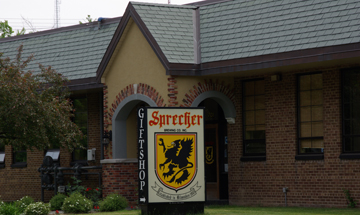 Although winery travelers and writers, we decided that since we were in Milwaukee it would be wise to stop at a microbrewery. The staff at Sprecher was quick to point out that we stopped at the best microbrewery in the area. Sprecher produces 13,000 barrels of beer annually. They make twenty different styles of beer and several different sodas. Their root beer is known nationally.
Although winery travelers and writers, we decided that since we were in Milwaukee it would be wise to stop at a microbrewery. The staff at Sprecher was quick to point out that we stopped at the best microbrewery in the area. Sprecher produces 13,000 barrels of beer annually. They make twenty different styles of beer and several different sodas. Their root beer is known nationally.
Wisconsin has a long history of breweries. By the 1880’s there were over 80 breweries in the state. That number drastically changed as a result of Prohibition. By 1933 there were a handful of breweries that survived. Randal Sprecher began Sprecher in 1985 and discovered rapid growth as the public became aware of the beers and sodas. By 1994 it was necessary to move to a larger location, its present location on West Glendale Avenue.
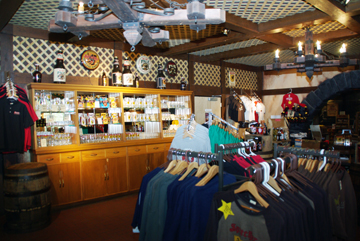 Upon entering the facility, visitors will see high walls of dark texture, almost reminiscent of castle walls. A slate floor lends to the ambiance of the room. Throughout this area, numerous styles of beer are available for purchase. Another section provides numerous clothing especially shirts with assorted styles, colors and sizes. Special shirts are available for children. Be sure to browse the food items available. Some of these include Beer Bread Mix, Pizza Beer, Beer Mustard, Fish Fry Batter, Ravin Red Bread-Cranberry Bread Mix, Orange Dream Brownie Mix, Root Beer BBQ Sauce and Root Beer Mustard.
Upon entering the facility, visitors will see high walls of dark texture, almost reminiscent of castle walls. A slate floor lends to the ambiance of the room. Throughout this area, numerous styles of beer are available for purchase. Another section provides numerous clothing especially shirts with assorted styles, colors and sizes. Special shirts are available for children. Be sure to browse the food items available. Some of these include Beer Bread Mix, Pizza Beer, Beer Mustard, Fish Fry Batter, Ravin Red Bread-Cranberry Bread Mix, Orange Dream Brownie Mix, Root Beer BBQ Sauce and Root Beer Mustard.
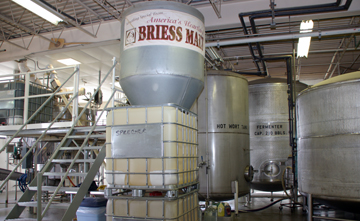 Anne Sprecher gave us a tour the brewery, bottling line and indoor beer garden. On the tour we met Jim Olen, one of the brewers. Jim explained the process of making beer. To make beer one needs only four ingredients: water, barley, hops and yeast. The first step at Sprecher Brewery is creating the mash in the Mash Tun, which breaks down the starch in the grain into fermentable and non-fermentable sugars. The mash is then placed in the Lauter Tun where the solids are filtered out; the remaining liquid consisting of fermentable sugars, the "wort," goes to the brew kettle where it is brought to a boil. Hops are added at various times during the boiling process. After this stage is completed, the wort is transferred to Hot Wort Tank where the residual hops solids and coagulated proteins from the boiling process settle out and leave the wort clear. Once the wort is cool enough, either lager or ale yeast is added and the wort moves to the Fermentation Tanks where it becomes the carbonated beverage known as beer, then into the cellar where it rests before being packaged in bottles or kegs.
Anne Sprecher gave us a tour the brewery, bottling line and indoor beer garden. On the tour we met Jim Olen, one of the brewers. Jim explained the process of making beer. To make beer one needs only four ingredients: water, barley, hops and yeast. The first step at Sprecher Brewery is creating the mash in the Mash Tun, which breaks down the starch in the grain into fermentable and non-fermentable sugars. The mash is then placed in the Lauter Tun where the solids are filtered out; the remaining liquid consisting of fermentable sugars, the "wort," goes to the brew kettle where it is brought to a boil. Hops are added at various times during the boiling process. After this stage is completed, the wort is transferred to Hot Wort Tank where the residual hops solids and coagulated proteins from the boiling process settle out and leave the wort clear. Once the wort is cool enough, either lager or ale yeast is added and the wort moves to the Fermentation Tanks where it becomes the carbonated beverage known as beer, then into the cellar where it rests before being packaged in bottles or kegs.
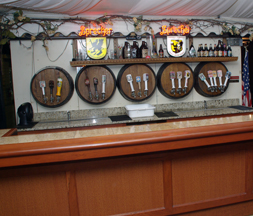
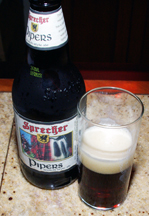 On the day of our visit we tasted several beers. The Black Bavarian was a dark brown color and had a noticeable coffee aroma and taste. The Special Amber is the best selling beer. It had a golden color and a smooth and refreshing taste. The Abbey Triple was a golden almost opaque color. It was very aromatic with fruit and floral nuances and a bit of honeysuckle on the taste. The Mai Bock, a golden translucent color, had a floral aroma and an astringent kick to the finish. Piper’s Scotch Ale was a red brown opaque color and offered a smoky aroma and a malt taste. The Russian Imperial Stout was dark brown. It had a distinctive coffee aroma and chocolate taste. It finished with a slight sweetness. This beer quickly grows on you.
On the day of our visit we tasted several beers. The Black Bavarian was a dark brown color and had a noticeable coffee aroma and taste. The Special Amber is the best selling beer. It had a golden color and a smooth and refreshing taste. The Abbey Triple was a golden almost opaque color. It was very aromatic with fruit and floral nuances and a bit of honeysuckle on the taste. The Mai Bock, a golden translucent color, had a floral aroma and an astringent kick to the finish. Piper’s Scotch Ale was a red brown opaque color and offered a smoky aroma and a malt taste. The Russian Imperial Stout was dark brown. It had a distinctive coffee aroma and chocolate taste. It finished with a slight sweetness. This beer quickly grows on you.
In addition to the beers we tasted the root beer. It had a root beer taste and was delicious and refreshing.
A visit to Sprecher is fun and educational. You can taste several crafted beers and discover what microbreweries have to offer. Sprecher Brewery offers public tours of the brewery every day during the summer and on weekends during the winter.
Sprecher Brewery
701 West Glendale Ave.
Glendale, Wisconsin
GPS: N43º 06.010 W87º 55.207
